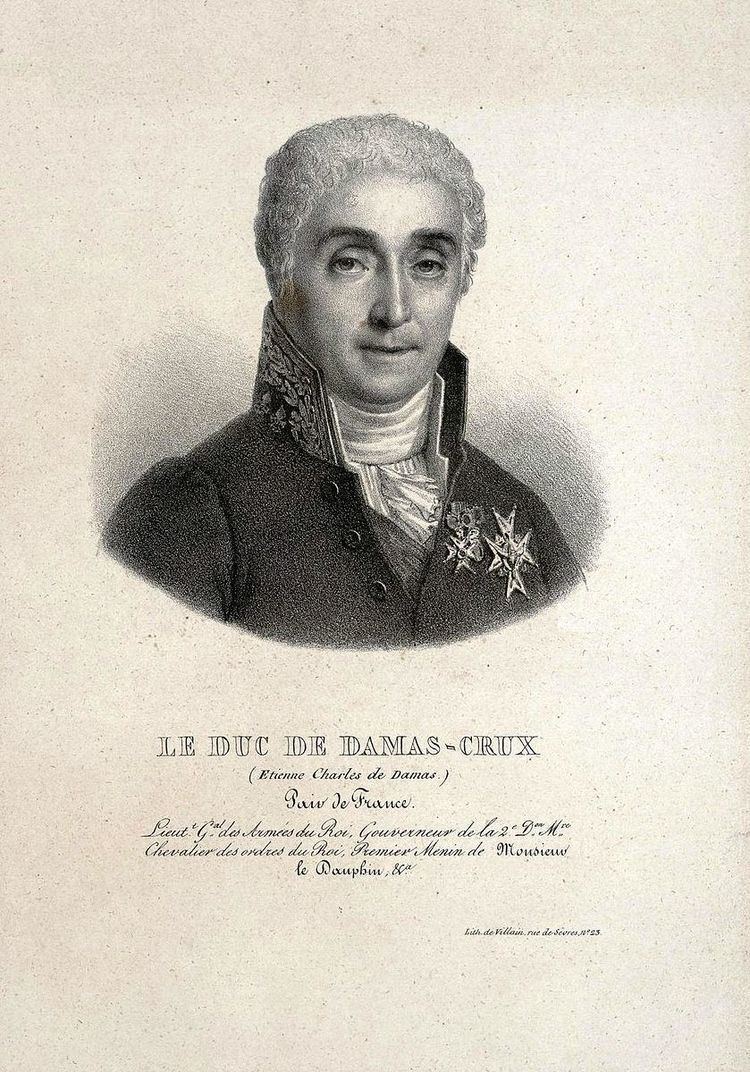 | ||
Name Etienne-Charles Damas-Crux | ||
Étienne-Charles, duke of Damas-Crux (10 February 1754, château de Crux, Nivernais region - 29 May 1846, Paris) was a French soldier and politician.
Contents

He derived from one of France's oldest noble families, the House of Damas - he was the last son of Louis Alexandre de Damas, count of Crux (died 1763) and his wife Marie-Louise (1712-1796), daughter of François-Charles, marquis of Menou (1671-1731). He became a brigadier des armées du roi and was received into the Knights of Malta.
Early service
Étienne-Charles joined the régiment de Limousin-infanterie as a sous-lieutenant on 22 February 1770 and rose to captain in the same regiment on 5 May 1772. He made second in command of the régiment d'Aquitaine on 3 October 1779 and fought with that regiment on all its campaigns in the East Indies during the American War of Independence. He was also put in command of a sepoy regiment and when one day this unit panicked and fled, Damas-Crux remained on the battlefield almost alone and was finally overrun and captured. Peace was concluded between France and Britain soon after his capture, enabling him to return to France, where he became a mestre-de-camp, commanding the régiment de Vexin-infanterie in 1784.
Revolution
On the French Revolution, Damas-Crux backed the king and emigrated - part of the Vexin-infanterie came to join him from the principality of Monaco and these men fought under his command in the 1792 campaign. In 1793 he raised the émigre 'Légion de Damas', leading it on the campaigns that year in the Netherlands. When the French Revolutionary Army invaded the Netherlands, the legion passed into British pay. The unit wished to land in western France, but this led to its infantry being largely destroyed on 21 July year III during the Quiberon expedition. In 1796 Damas-Crux concluded a surrender with the prince de Condé that allowed Damas-Crux to form a squadron of hussars out of the remains of his legion - he then commanded this squadron as part of the armée de Condé.
In 1795 Louis XVIII (or the count of Artois) had promoted Damas-Crux to maréchal-de-camp. He followed Condé's army to Poland in 1801 and he and Condé joined the Russian army the following year. Damas-Crux was duke of Angoulême's attaché in Russia, as first gentleman of the chamber, and accompanied him from Mittau to join Condé's army, then to Warsaw and finally to England. In 1799 he married Anne-Félicité-Simone (Paris, 15 January 1772 - Paris, 25 January 1848), daughter of Bonne Marie Félicité de Montmorency-Luxembourg and Armand, duke of Sérent, peer of France, governor of the royal château de Rambouillet, knight of the king's orders, former governor of the dukes of Angoulême and Berry and former president of the nobility in the Estates of Brittany.
Bourbon Restoration
He finally returned to France in March 1814 with the Coalition armies and joined the duke of Angoulême in his trip to the MIDI, "helping him in his counsels and his arms" on all occasions. On the following 21 March (or 22 June) he was made lieutenant-général des armées du Roi and on 22 August 1814 a knight grand cross of the Order of Saint Louis. He initially accompanied the Duke of Angoulême during the Hundred Days. He was sent to Toulouse as a king's commissioner alongside the baron of Vitrolles, but was arrested by order of de Laborde and conducted to the Spanish frontier. He then rejoined the Duke of Angoulême in Madrid, from which he was sent to Tolosa and Irun to enlist French Royalists there. De Damas-Crux entered Bayonne on 25 July, escorted by 1,800 Basques who he had recruited. He had refused all help from the Spanish general Enrique José O'Donnell, who had offered to put his force under de Damas-Crux's orders. After Napoleon's defeat, de Damas-Crux was made governor of the 11th and 20th military divisions and commander of the armée des Pyrénées occidentales.
On 17 July 1815 he was made a peer of France, voting for the death sentence for Michel Ney. On 3 February 1816 he was made a duke in return for his services during the Napoleonic Wars and took an oath to obey the royal court at that rank on 19 February. He was made a knight of the king's orders in Paris on 5 February 1824, taking this up formally on 14 May 1826. On 26 September 1815 he was replaced as commander of the 11th military division by the duc de Gramont, moving instead to the 25th division (Corsica) and then on 10 January 1816 to the 2nd military division. In March 1816 the duke of Angoulême gave him various missions in the Midi, which he completed - the measures he took, however, undermined the royal family's in that area.
De Damas-Crux retired from the upper chamber after the July Revolution, after remaining faithful to the old government and refusing to take an oath to obey the new one. He retired from the army at the rank of lieutenant general on 30 June 1832 and died in Paris fourteen years later. He and his wife had no issue so the Damas-Crux branch (the oldest branch of the house of Damas) died out with him - he had taken measures to be succeeded in the peerage by Alexandre de Damas, but since Étienne-Charles had been dismissed from the peerage for refusing to take the oath to Louis Philippe his heir could not sit in the house of peers.
